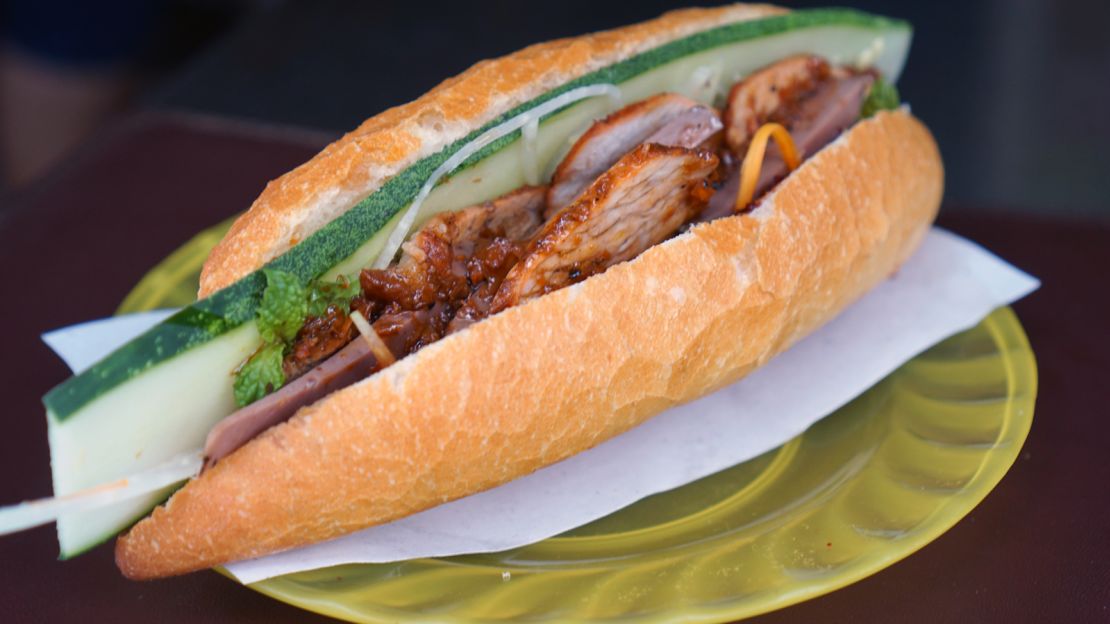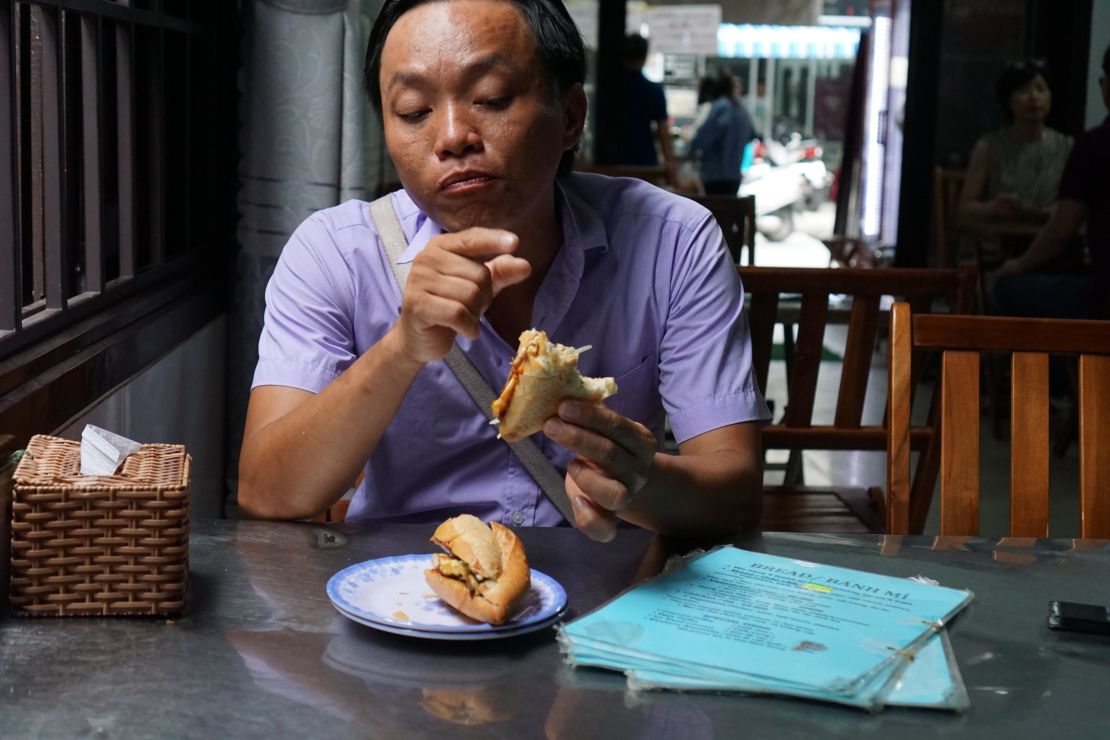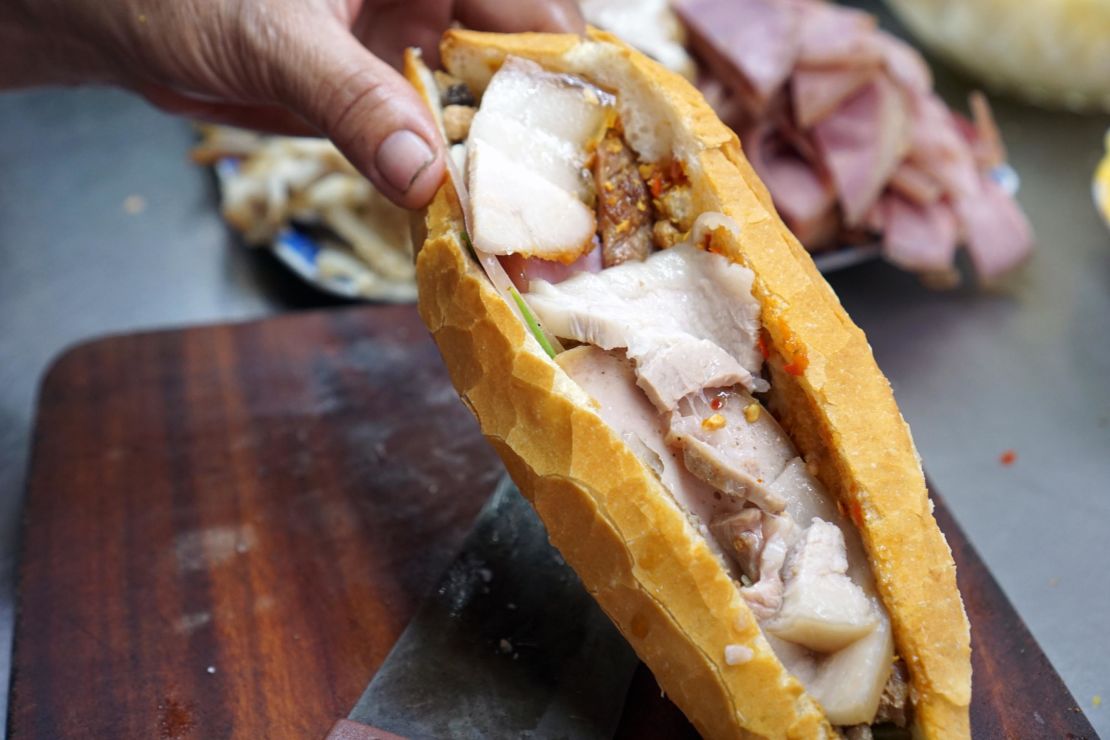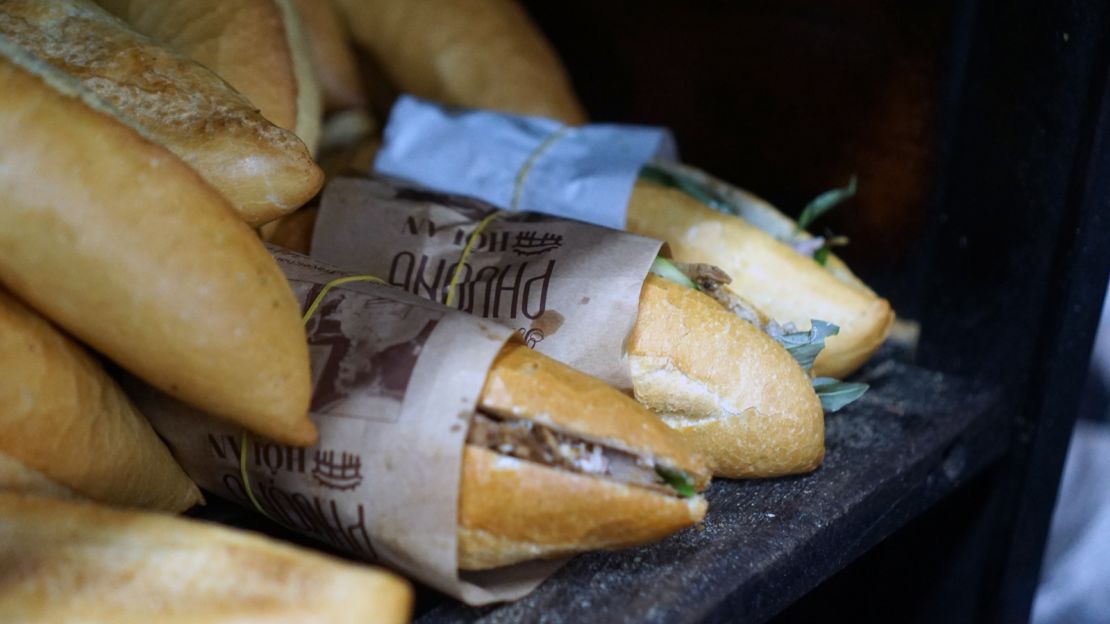Walking through Hoi An’s Old Town, in central Vietnam, the omnipresent buzz of motorbikes fills the air.
Vendors push carts overloaded with ceramic vases and bowls. A pedicab slows down to offer a ride.
A woman touts custom-made tailoring and leather bags from a store, where a lush curtain of foliage falls from the rooftop.
But I am single-minded in my mission: To find the best banh mi in Hoi An – and maybe even the world.
Banh mi basics
The king of sandwiches brings together several cultural traditions all in one crispy bun, namely a golden French baguette (introduced to Vietnam by French colonists in the late 19th century), pork paté, Chinese char siu (barbecued pork), American hamburger meat, mayonnaise and a mix of Vietnamese herbs and chili sauces.
To assist in my quest, Huynh Huu Phuoc – a Hoi An local and founder of Eat Hoi An street food tours and cooking classes – has shortlisted a few of his top banh mi stalls and restaurants.
“If there’s one thing to eat in Hoi An, I must say it’s banh mi,” Huynh tells CNN Travel. “We have the best banh mi in the world.
“Eating is really part of our culture – it’s a fashion and a passion. You can eat banh mi all day. Breakfast, lunch, dinner, fast snack … there’s no right time to eat it.”
Phi Banh Mi

Huynh says the “real Hoi An” isn’t in Old Town, so we hop on his motorcycle to ride northwest to Zone B.
“Locals don’t really have any interest in Old Town, aside from work,” he says.
“If you want to see and eat things that are authentic, you really have to go to Zone B. That’s where most locals live – and that’s where you will mostly see the real life.”
We stop on a relatively quiet street, where he points to Phi Banh Mi: An open-air restaurant with red stools and stainless-steel tables.
“The banh mi here is created by Do Van Phi, a former chef at the Nam Hai (now the Four Seasons Nam Hai),” says Huynh. “He has so much knowledge of professional kitchens.”
Prepared in a matter of seconds, the banh mi comes topped with an abundance of herbs – Vietnamese mint (which tastes like coriander), mint, spring onions, basil – and a spicy helping of homemade chili sauce.
What makes this banh mi special is the roasted pork belly. “The best part of the pig is the belly, but every pig has a different flavor and taste,” says Huynh. “A free-range pig will taste better – and that’s what he uses.”
Phi heads to the Central market every morning to collect fresh ingredients from the best vendors. “He has really good pork belly – they always save the best for him,” says Huynh.
Cam Pho, Hoi An Vietnam, 88 Thai Phien, Phuong Minh An, Hoi An, Quang Nam, Vietnam
Madam Khanh - The Banh Mi Queen

A well-known brick-and-mortar restaurant, Madam Khanh is nicknamed the Banh Mi Queen for good reason.
Now in her 90s, Nguyen Thi Loc set up her banh mi business in 1975 and ran it for 45 years – nearly half her life. Though her daughter runs the show now, she often stops by in the mornings to help out.
“Her bread is really nice and she packs each sandwich with fresh herbs and homemade mayonnaise,” says Huynh.
“She also makes homemade paté from pig liver, seasoned with crushed shallot, lemongrass, pepper, salt, tiny bit of MSG inside.”
Since the second generation took over, Huynh says the banh mi have become more modern and, in some ways, more tailored for foreigners.
The family introduced a bigger menu – including vegetarian, beef and fish banh mi – plus a slightly sweet sauce and added an omelet inside.
“The omelet is definitely not too traditional,” says Huynh. “We’ve never done that in the past, but this is kind of a new idea and people really liked it. It’s like a fancy-style baguette. But I’d say it’s sweet and less spicy than the traditional.”
115 Tran Cao Van, Phuong Minh An, Hoi An, Quang Nam, Vietnam
La Banh Mi Sai Gon Tai Hoi An

Located in western Hoi An, La Banh Mi Sai Gon Tai Hoi An is a nostalgic stop for Huynh.
“When I was a kid, I came here every day in the early morning to eat her banh mi,” he recalls.
Born in Ho Chi Minh City, the owner of La Banh Mi Sai Gon Tai Hoi An, named Ta Thi Nghia, moved to Hoi An 20 years ago looking for new opportunities.
She quickly found a niche, setting up a roadside banh mi stall that Hoi An residents loved. Later, she expanded to a second location that her daughter runs.
It doesn’t look like much other than a stall and a few plastic stools, but the family-run operation works to extract as much flavor as possible from each ingredient.
“Her banh mi is a little bit different, because it has southern tradition,” says Huynh. “She uses extra fatty rolled pork belly instead of char siu and plenty of green chili for heat. She also makes her mayonnaise – using egg, oil and yogurt for a slightly sour taste.”
But the most memorable ingredient is the paté. Off to the right, a wood-fired oven opens to reveal flames, licking a batch of fresh pork liver paté.
“This is the correct way to cook paté – really, really slow with the open fire like this,” says Huynh. “After it’s done, they let it burn a little bit. Then they bake it up, burning it again, to make the flavor much stronger. There’s no rush here. They let it cook nice and slowly.”
Even though she’s not cooking for foreigners, her banh mi does run a little on the sweet side. That’s due to her Hoi Chi Minh City heritage.
“Her recipes are from the South, which is more influenced by the Khmer (Cambodian) culture,” says Huynh. “They eat more palm sugar and add it in the cooking, so food tends to be slightly sweeter.”
151 Tran Hung Dao, Hoi An, Quang Nam, Vietnam
Banh Mi Phuong

The most famous banh mi in the world, Banh Mi Phuong sells roughly 3,000-4,000 sandwiches per day.
“Seven years ago, a guy with a camera came by, ordered a bahn mi and said: ‘This is the best banh mi in the world,’” says Huynh. “That was Anthony Bourdain. Afterwards, they got lots of international attention and became famous.”
Huynh says the hype – and resulting lines out the door – are well deserved.
Started by Truong Thi Phuong (aka Madam Phuong)’s parents, the business “opened doors” roughly 55 years ago. They ran it for about 25 years, before passing it on to their eldest daughter.
Madam Phuong, then a teacher, was totally overwhelmed. But her boyfriend Dang Ng?c Chau – who had a highly coveted government police job at the time – quit to help her.
He became the creative force behind the operation, taking over the kitchen (then in the Central Market) and refining the recipes.
“At that time, for a young man to leave such a good job and start working in a kitchen, it was looked down upon,” says Huynh. “He is really a hero of love.”
After winning over local eaters, the pair moved into a brick-and-mortar restaurant. They were very strategic about the location: right next to Hoi An’s best bakery.
“The most important thing about banh mi is the bread. It has to be fresh – crispy on the outside, soft on the inside,” says Huynh. “Their location is really smart. Now they have a steady stream of fresh baguettes.”
As for the taste? The restaurant has one of the largest menus with everything from vegetarian banh mi to bacon and beef.
In the traditional version, the baguette explodes with fresh ingredients, such as barbecued pork, spicy chili, a bundle of fresh herbs and yolky mayonnaise.
“Her husband is the brains in the kitchen,” says Huynh. “He has all the recipes, shows up at 4:30 a.m. to start preparation every day. He is the heart of this place.”
2B Phan Chu Trinh, Cam Chau, Hoi An, Quang Nam, Vietnam
Banh Mi Lanh

A tiny stall near the Chua Nam Quang Tu pagoda in northeast Hoi An, Banh Mi Lanh draws a following among local residents.
In business for about 30 years, the stall is run by Khuu Thi Lanh, who pumps out baguettes at lightning speed under the shade of a tin roof.
“This flavor is really the most authentic in Hoi An,” says Huynh. “They use the same bread as Madam Phuong’s and homemade paté, baked the traditional way in a lemongrass and shallot marinade.”
The baguette isn’t too sweet, nor too saucy, and the bread tastes light and airy.
“The local people, when we eat a banh mi, we sit down at the stall on the stools,” says Huynh.
“The first bite of a banh mi isn’t ever really that good. But that second bite… mmm. That’s when you start to get all the fillings, and the bread, in one bite. That’s when it tastes really good.”
Cam Chau, Hoi An, Quang Nam, Vietnam

















